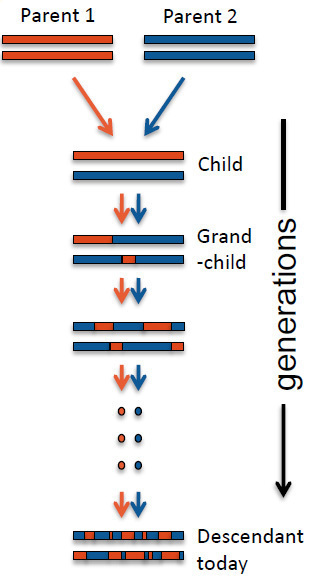An interactive map of human genetic history
Researchers have produced a global map detailing the genetic histories of 95 different populations across the world, spanning the last 4000 years. The map demonstrates how when individuals from different groups interbreed, their offspring’s DNA becomes a mixture of the DNA from each group, with pieces of this DNA carrying on all the way to the present day.
The researchers, from the Max Planck Institute for Evolutionary Anthropology, Oxford University and University College London (UCL), developed a technique named ‘Globetrotter’ to follow the genetic traces of admixture back to the nearest extant population. Their results, which follow the genetic impacts of over 100 historical events, have been published in the journal Science.
“We have developed an approach that exploits the genomic structure of admixed populations to date and characterise historical mixture events at fine scales,” the researchers said. They used genome data from 1490 individuals in 95 populations to identify pieces of DNA that were shared between individuals from different populations. Populations sharing more ancestry share more pieces, and individual pieces give clues about the underlying ancestry along chromosomes.

“Each population has a particular genetic ‘palette’,” said Daniel Falush, co-senior author from the Max Planck Institute for Evolutionary Anthropology. “If you were to paint the genomes of people in modern-day Maya, for example, you would use a mixed palette with colours from Spanish-like, West African and Native American DNA. This mix dates back to around 1670 AD, consistent with historical accounts describing Spanish and West African people entering the Americas around that time. Though we can’t directly sample DNA from the groups that mixed in the past, we can capture much of the DNA of these original groups as persisting, within a mixed palette of modern-day groups.”
“Although individual mutations carry only weak signals about where a person is from, by adding information across the whole genome we can reconstruct these mixing events,” added lead author Garrett Hellenthal, from the UCL Genetics Institute. “Sometimes individuals sampled from nearby regions can have surprisingly different sources of mixing. For example, we identify distinct events happening at different times among groups other than the Hazara sampled within Pakistan, with some inheriting DNA from sub-Saharan Africa, perhaps related to the Arab Slave Trade, another from East Asia and yet another from ancient Europe.”
These events are showcased in the researchers’ interactive map, which details the histories of genetic mixing between populations across Europe, Africa, Asia and South America. Not only is it said to be the first map to simultaneously identify, date and characterise genetic mixing between populations, it also provides insight into the events that caused them.
Historical records suggest that the Hazara people of Pakistan are partially descended from Mongol warriors, and the study found clear evidence of Mongol DNA entering the population during the period of the Mongol empire. Six other populations, from as far west as Turkey, showed similar evidence of genetic mixing with Mongols around the same time.
“We identified events whose dates and participants suggest they describe genetic impacts of the Mongol empire, Arab slave trade, Bantu expansion, first millennium CE migrations in Eastern Europe, and European colonialism, as well as unrecorded events, revealing admixture to be an almost universal force shaping human populations,” the researchers said.
Dr Simon Myers, co-senior author of the study from Oxford University’s Department of Statistics and Wellcome Trust Centre for Human Genetics, speculated on one such unrecorded event. “The DNA of the Tu people in modern China suggests that in around 1200 CE, Europeans similar to modern Greeks mixed with an otherwise Chinese-like population. Plausibly, the source of this European-like DNA might be merchants travelling the nearby Silk Road.”
As well as providing fresh insights into historical events, the research might have implications for how DNA impacts health and disease in different populations.
“Some populations are more at risk of certain diseases than others, and drug efficacy is also known to vary significantly,” said Dr Myers. “Rare genetic mutations are particularly likely to show strong differences between populations, and understanding their role in our health is an area of intense current research efforts. We hope in future to include even more detailed sequencing, to spot these rare mutations and better understand their global spread.”
The research was funded by the Oxford University John Fell Fund, the National Institutes of Health (USA), the Wellcome Trust, the Biotechnology and Biological Sciences Research Council and the joint Royal Society/Wellcome Trust Sir Henry Dale Fellowship. The map is available at http://admixturemap.paintmychromosomes.com/.
Blood test for chronic fatigue syndrome developed
The test addresses the need for a quick and reliable diagnostic for a complex,...
Droplet microfluidics for single-cell analysis
Discover how droplet microfluidics is revolutionising single-cell analysis and selection in...
PCR alternative offers diagnostic testing in a handheld device
Researchers have developed a diagnostic platform that uses similar techniques to PCR, but within...







